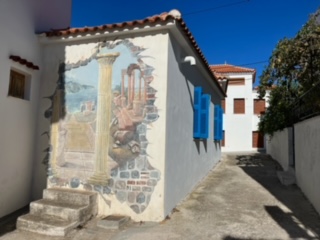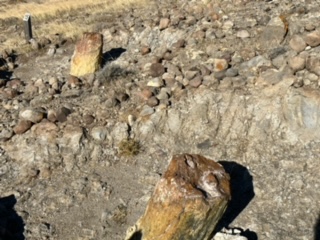39:09.645N 23:53.188E

Muskrat
Chris and Alison
Mon 16 Oct 2023 12:21
We had to motor all the way to Sigri after waiting out some strong wind in Apothekes. It’s all or nothing at the moment.
Sigri has a lovely anchorage, sheltered and right next to a beach and it has a landing place for the dinghy. We got ourselves tucked well in to get out of the swell and were well sheltered from the northerly wind forecast for the next few days.
Lesvos has an exceptional ecosystem. Sigri and its surrounding area was made a UNESCO Geopark in 2000. The exceptional ecological value of Lesvos’ has resulted in the recognition of three areas that host particular types of natural habitats and living organisms which are important at a European level. The western peninsular with its petrified forest, the wetlands of the Gulf of Kalloni and the wetlands of the Gulf of Gera and Mount Olympus.
The main feature of ecosystems in Lesvos’ is the close correlation between the type of vegetation and the underlying rocks.
The geological heritage and natural environment of Lesvos’ is also connected to the foundation of science studies by Artistotle and Theophrastus. Being fascinated by the natural world, Aristotle studied the animals around the Gulf of Kalloni in 347 BC. His student, Theophrastus, who is considered as the founder of botany, ecology and mineralogy, was the first to take notice of fossils.
We made a start of visiting this fascinating area with a visit to the Natural history museum of the Lesvos Petrifed Forest situated in Sigri. This is a window to the geological history of the Aegean area during the last 300 million years. The most fascinating feature for me was the formation of the Petrified Forest. It is one of the most finest and rarest geomonuments worldwide. Its creation was a result of volcanic activity that caused volcanic materials to cover and fossilise trees in their natural growth positions and preserving them for 300 million years. While you can visit the largest Petrified Forest, that is about 12km from Sigri, we saw enough petrified trees in and around Sigri to appreciate the beauty and the intense geotectonic processes that have shaped this landscape.
A weather window that we had been waiting for to cross the Northern Aegean arrived so we left Sigri and its petrified trees and headed West. We had good crossing starting off with a nice F4 NNW doing 7kts, as the night closed in the wind dropped, but we continued to sail and arrived in Alonissios 24 hours and 24 minutes after leaving Sigri. We only used the engine for pilotage. During the night on my watch I had dolphins playing in the bow wave but with no phosphorescence I was unable to see them, unlike during the day when we had a pod swimming past as soon as we left Sigri. The night watches are now chilly and very damp due to the dew, so the foulies and socks appeared on deck once the sun had gone down. Chris kept his slippers on during his watch!
During the night we started to approach the National Marine Park of Alonnisos and Northern Sporades. This has been set up to try to protect the endangered Monk Seal population and the fragile ecosystem of the Northern Mediterranean. Anyone entering the bounded area has to pay to sail into, through or stay in the protected area zone “A”. Zone “B” you don’t have to pay to visit but have to adhere to the restrictions for anchoring and some areas are out of bounds. For our size yacht the payment was €33.50 per day for the yacht and €5.50 per day per person. Chris being “elderly” only had to pay €2.50 per day!! We paid this before leaving Sigri as we would be sailing through the area during the night.
We anchored in a sheltered bay on the East coast of Alonnisos in beautiful clear water surrounded by pine trees and olive groves. The only taverna on the beach was closed for the winter, so we had the bay to ourselves except for the occasional local having a swim.
Sigri street art work
Petrified trees 300 million years old. It was more interesting than they look - honest.

